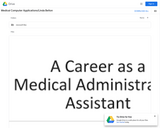
Full course in Medical Computer Applications.
- Subject:
- Career and Technical Education
- Material Type:
- Full Course
- Provider:
- Springfield Technical Community College
- Author:
- Linda Belson
- Date Added:
- 05/15/2019

Full course in Medical Computer Applications.
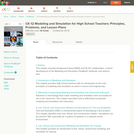
A collaboration between the National Aeronautics and Space Administration (NASA) and the CK-12 Foundation, this book provides high school mathematics and physics teachers with an introduction to the main principles of modeling and simulation used in science and engineering. An appendix of lesson plans is included.
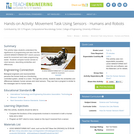
This activity helps students understand the significance of programming and also how the LEGO MINDSTORMS(TM) NXT robot's sensors assist its movement and make programming easier. Students compare human senses to robot sensors, describing similarities and differences.
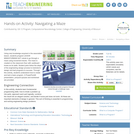
Using new knowledge acquired in the associated lesson, students program LEGO MINDSTORMS(TM) NXT robots to go through a maze using movement blocks. The maze is created on the classroom floor with cardboard boxes as its walls. Student pairs follow the steps of the engineering design process to brainstorm, design and test programs to success. Through this activity, students understand how to create and test a basic program. A PowerPoint® presentation, pre/post quizzes and worksheet are provided.
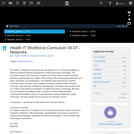
This unit covers the history and evolution of computer networks, including the various types of network communications. Various forms of networking addressing are also covered, including network topologies, standards and protocols, logical model concepts, network hardware, and wireless communication.
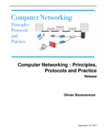
"Computer Networking : Principles, Protocols and Practice" is an open-source ebook that explains the main principles of Computer Networking and the key protocols that are used on the Internet.
The first part describes the theoretical foundations of this domain as well and the main algorithms and protocols.
The ebook is intended to be used for an upper-level undergraduate networking course. The second part contains a detailed explanation of the main Internet protocols including HTTP, DNS, TCP, UDP, IPv6, BGP, RIP, OSPF, Ethernet and WiFi.
The last part contains exercises and practical labs to allow the students to test their knowledge.
The Computer Networking: Principles, Protocols and Practice textbook is one of the winners of the first Open Textbook challenge organised by the Saylor foundation in the US.

Contient la partie théorique du support du cours SINF1252 donné aux étudiants en informatique à l’Université catholique de Louvain (UCL).
Consulter la page du cours pour d'autre formats et exercices => http://sites.uclouvain.be/SystInfo/
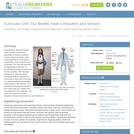
Students learn about the human body's system components, specifically its sensory systems, nervous system and brain, while comparing them to robot system components, such as sensors and computers. The unit's life sciences-to-engineering comparison is accomplished through three lessons and five activities. The important framework of "stimulus-sensor-coordinator-effector-response" is introduced to show how it improves our understanding the cause-effect relationships of both systems. This framework reinforces the theme of the human body as a system from the perspective of an engineer. This unit is the second of a series, intended to follow the Humans Are Like Robots unit.
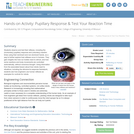
Students observe and test their reflexes, including the (involuntary) pupillary response and (voluntary) reaction times using their dominant and non-dominant hands, as a way to further explore how reflexes occur in humans. They gain insights into how our bodies react to stimuli, and how some reactions and body movements are controlled automatically, without conscious thought. Using information from the associated lesson about how robots react to situations, including the stimulus-to-response framework, students see how engineers use human reflexes as examples for controls for robots.

This class deals with the modeling and analysis of queueing systems, with applications in communications, manufacturing, computers, call centers, service industries and transportation. Topics include birth-death processes and simple Markovian queues, networks of queues and product form networks, single and multi-server queues, multi-class queueing networks, fluid models, adversarial queueing networks, heavy-traffic theory and diffusion approximations. The course will cover state of the art results which lead to research opportunities.
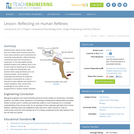
Students learn about human reflexes, how our bodies react to stimuli and how some body reactions and movements are controlled automatically, without thinking consciously about the movement or responses. In the associated activity, students explore how reflexes work in the human body by observing an involuntary human reflex and testing their own reaction times using dominant and non-dominant hands. Once students understand the stimulus-to-response framework components as a way to describe human reflexes and reactions in certain situations, they connect this knowledge to how robots can be programmed to conduct similar reactions.
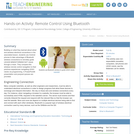
Building on what they learned about wired and wireless electrical connections in the associated lesson, students use Android phones to take advantage of Bluetooth wireless connections to remotely guide LEGO MINDSTORMS(TM) NXT robots through a maze. They compare this wireless remote control navigation to their previous experiences navigating LEGO robots via programming. A PowerPoint® presentation and pre/post quizzes are provided.
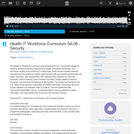
This unit covers common security concerns and safeguards, including firewalls, encryption, virus protection software and patterns, and programming for security. Additional topics include security of wireless networks, and concerns, mitigations, and regulations related to healthcare applications.

This course will consider the ways in which technology, broadly defined, has contributed to the building of American society from colonial times to the present. This course has three primary goals: to train students to ask critical questions of both technology and the broader American culture of which it is a part; to provide an historical perspective with which to frame and address such questions; and to encourage students to be neither blind critics of new technologies, nor blind advocates for technologies in general, but thoughtful and educated participants in the democratic process.
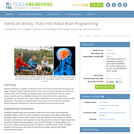
With the challenge to program computers to mimic the human reaction after touching a hot object, students program LEGO® robots to "react" and move back quickly once their touch sensors bump into something. By relating human senses to electronic sensors used in robots, students see the similarities between the human brain and its engineering counterpart, the computer, and come to better understand the functioning of sensors in both applications. They apply an understanding of the human "stimulus-sensor-coordinator-effector-response" framework to logically understand human and robot actions.

The goal of this book is to teach you to think like a computer scientist. This way of thinking combines some of the best features of mathematics, engineering, and natural science. Like mathematicians, computer scientists use formal languages to denote ideas (specifically computations). Like engineers, they design things, assembling components into systems and evaluating tradeoffs among alternatives. Like scientists, they observe the behavior of complex systems, form hypotheses, and test predictions.

Student pairs first act out the instructions a robot is given with one person providing instructions and the other person following the instructions. This activity helps students understand how robots are programmed and with what type of precision commands must be given. Then students program LEGO MINDSTORMS(TM) NXT taskbots to navigate a simple maze. The goal is to teach students that robot computers simply follow directions exactly as they are given, thus one must be very clear and logical with programming instructions.
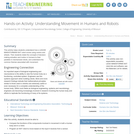
This activity helps students understand how a LEGO MINDSTORMS(TM) NXT robot moves using motors and wheels. Then students relate the concepts of decision-making actuation and motion in humans to their parallels in mechanized robots, and understand the common themes associated with movement.

The basic objective of Unified Engineering is to give a solid understanding of the fundamental disciplines of aerospace engineering, as well as their interrelationships and applications. These disciplines are Materials and Structures (M); Computers and Programming (C); Fluid Mechanics (F); Thermodynamics (T); Propulsion (P); and Signals and Systems (S). In choosing to teach these subjects in a unified manner, the instructors seek to explain the common intellectual threads in these disciplines, as well as their combined application to solve engineering Systems Problems (SP). Throughout the year, the instructors emphasize the connections among the disciplines.
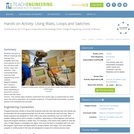
Students are given a difficult challenge that requires they integrate what they have learned so far in the unit about wait blocks, loops and switches. They incorporate these tools into their programming of the LEGO MINDSTORMS(TM) NXT robots to perform different tasks depending on input from a sound sensor and two touch sensors. This activity helps students understand how similar logic is implemented for other every day device operations via computer programs. A PowerPoint® presentation, pre/post quizzes and worksheet are provided.